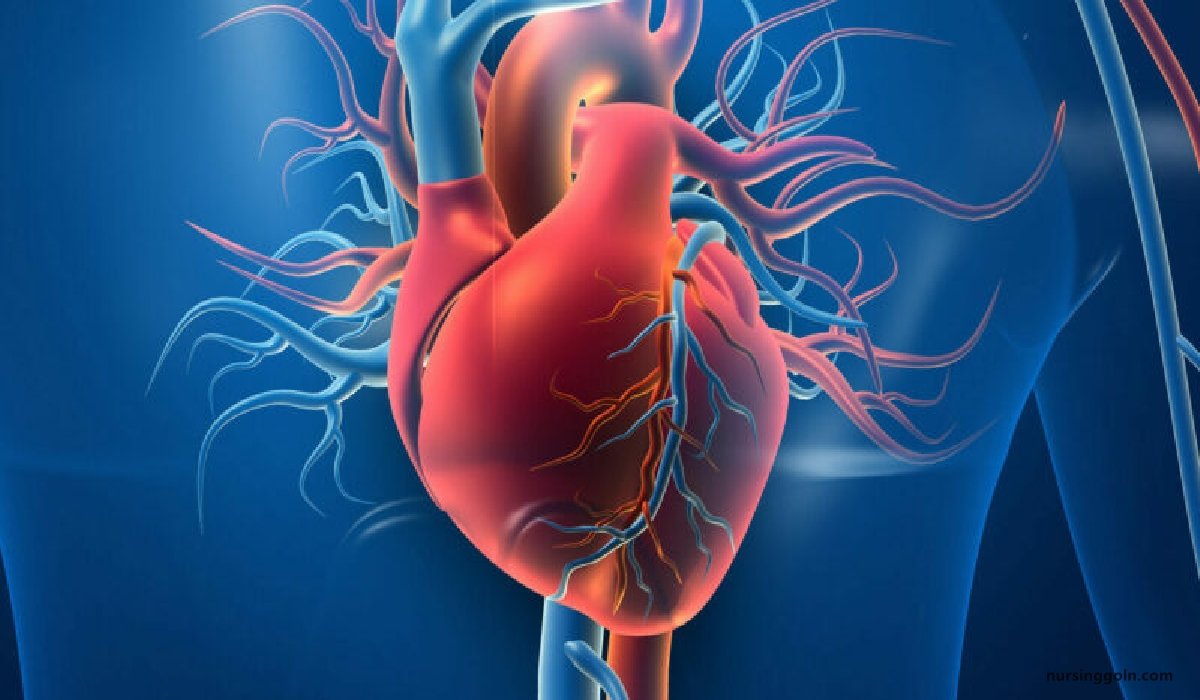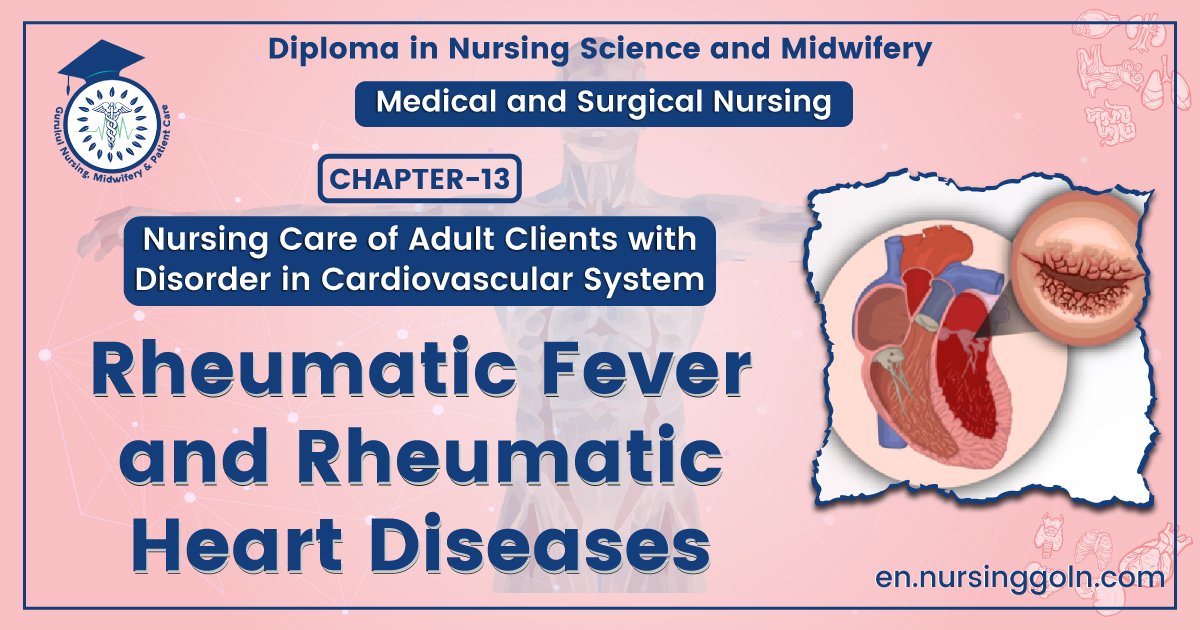Rheumatic fever and rheumatic heart diseases – This course is designed to understand the concept of community health nursing: nurses’ roles and interventions in family health, school health, occupational health, environmental health, elderly health care, gender issues, disaster management and principles and terminology of epidemiology. The aim of the course is to acquire knowledge and skills in community health nursing.

Rheumatic fever and rheumatic heart diseases
Rheumatic fever is an inflammatory disease that can develop as a complication of inadequately treated strep throat or scarlet fever. Strep throat and scarlet fever are caused by an infection with streptococcus bacteria.
Rheumatic fever is most common in 5- to 15-year-old children, though it can develop in younger children and adults. Although strep throat is common, rheumatic fever is rare in the United States and other developed countries. However, rheumatic fever remains common in many developing nations.
Rheumatic fever can cause permanent damage to the heart, including damaged heart valves and heart failure. Treatments can reduce damage from inflammation, lessen pain and other symptoms, and prevent the recurrence of rheumatic fever.
Definition of Rheumatic fever:
Acute rheumatic fever (ARF) is an acute autoimmune collagen disease occurs as a hypersensitivity reaction to group-A beta hemolytic streptococcal infection. It is characterized by inflammatory lesions of connective tissue and endothelial tissue.
(Ref: Paediatric Nursing, Parul Datta/34/311)
Rheumatic fever is a multisystem, nonsuppurative, inflammatory diseases involving the joints, heart, CNS, skin or subcutaneous tissue triggered by a group A B-hemolytic streptococcal infection of the upper respiratory tract.
Epidemiological Features of Rheumatic Fever
A) Agent factors
a) Agent: previous streptococcal sore throat
b) Carrier: Convalescent, transient and chronic carriers
B) Host factors
a) Age: It is a disease of childhood and adolescent (5-15 years)
b) Sex: Female > Male
e) Immune response: It leads to development of rheumatic fever
C) Environmental factors
a) Socio economic status: Poverty, overcrowding, poor housing conditions, inadequate health services.
b) High risk groups:
- School age children between 5-15 years
- Slum dwellers
- Living in barracks
Clinical Features:
History:
- History of sore throat 1-3 weeks back in children usually between 5-15 years of age.
- Scarlet fever
Clinical features:
1. Fever
2. Joint pain (Arthritis)
3. Carditis:
- Dyspnoea
- Palpitation, central chest pain, breathlessness
- Syncope
- Pericardial friction rub
- Carey coombs murmur
- Oedema
- Aortic or mitral regurgitation
- Heart block
4. Migratory polyarthritis and arthralgia: Affect large joints knees, ankles, elbows and wrists.
5. Sydenham’s chorea
6. Erythema marginatum
7. Erythema nodosum
8. Subcutaneous nodule
Jones Criteria for the Diagnosis of Rheumatic Fever:
A. Major criteria:
- Carditis
- Polyarthritis
- Chorea
- Erythema marginatum
- Subcutaneous nodule
B. Minor criteria:
- Fever
- Arthralgia
- Previous rheumatic fever
- Raised ESR or C-reactive protein
- Leukocytosis
- First degree AV block
C. Plus: Supporting evidence of preceding streptococcal infection –
- Recent scarlet fever
- Raised antistreptolysin O or other streptococcal antibody.
- Positive throat culture for streptococcus
D. For diagnosis of rheumatic fever:
- 2 or more major criteria or
- 1 major criteria and 2 or more minor criteria + (plus) Evidence of preceding streptococcal infection
If carditis or chorea is present, no secondary support is required to diagnosis acute rheumatic fever
Causes of Rheumatic Fever:
1. Exact cause is unknown
2. May be due to-
- Cold weather
- Overcrowding
- Unhygienic condition
- Poor socio economic condition
- Upper RTI by streptococcus ẞ-hemolyticus
3. If there is-
- H/O sore throat 2-3 weeks ago, before symptoms appear.
- Streptococcus ẞ-hemolyticus is isolated from throat swab
Investigation of Rheumatic Fever:
a) Evidence of systemic illness: (non-specific)
- TC-Leukocytosis
- ESR-Raised
- C-reactive protein (CRP) – raised
b) Evidence of preceding streptococcal infection: (Specific) –
- Throat swab culture: Group A B-haemolytic streptococci (also from family members and contacts)
- Antistreptolysin O antibodies (ASO titres): Rising titres, or levels of > 200 Unit (adults) or> 300 Unit (children)
c) Evidence of carditis:
- Chest X-ray: Cardiomegaly; pulmonary congestion
- ECG: first and rarely second degree heart block; features of pericarditis; T-wave. inversion; reduction in ORS voltages
- Echocardiography: Cardiac dilation and valve abnormalities.

Treatment of Rheumatic Fever:
a) Treatment of the acute attack-
- A single dose of benzyl penicillin 1.2 million unit intramuscular or
- Oral phenoxymethyl penicillin 250 mg 6 hourly for 10 days should be given on diagnosis to eliminate any residual streptococcal infection.
- If the patient is penicillin allergic, erythromycin or cephalosporin can be used.
b) Bed rest and supportive therapy:
Bed rest: until-
- The patient is feeling well
- Symptoms have subsided
- Pain and fever is absent
- The patient is gaining weight
- Sleeping pulse rate is normal
- Hb% level is improving
- Leucocytosis and ESR become normal
c) Analgesic:
- If only arthralgia – Analgesics only
- If arthritis: Aspirin
✔ Initial dose is 60 mg/kg/day, divided into 6 doses
✔ Then dose can be increased upto 120 mg/kg/day, but not exceeding 8 gm/day.
✔ Drug is continued for 4-6 weeks until ESR and other parameter comes to normal.
d) Corticosteroids:
- These produce more rapid symptomatic relief than aspirin, and are indicated in cases with carditis or severe arthritis.
- Prednisolone, 1-2 mg/kg/day in divided doses, should be continued until the ESR is normal than tailed off.
e) Follow up-
- By echo, yearly or 2 yearly – for 10 day
Nursing Management of Rheumatic Fever:
Nursing interventions should emphasize along with routine care:
Improving cardiac output by:
- Providing rest as long as rheumatic activity and heart failure persist. In milder cases light indoor activity is allowed.
- Organizing nursing care with uninterrupted rest and modifying activities.
- Maintaining normal body temperature by managing fever.
- Providing bland diet with adequate nutrition and fluid intake with salt restriction in case of CCF.
- Administering medication as prescribed with necessary precautions.
- Monitoring cardiac functions, intake-output and features of improvement or deterioration,
Relieving pain by:
- Administering anti-inflammatory analgesics as prescribed and assessing features of aspirin toxicity.
- Providing comfortable position and support to the inflamed joints.
- Arranging diversional activities and play materials according to age and choice of the child.
Protections the child from injury by:
- Removing hard and sharp objects from the child’s reach.
- Assisting the child in feeding, ambulation and other fine motor activities and channelization of the stress.
- Administration of drugs to control the chorea.
- Explaining about self-limiting course of the condition and importance about physical and mental rest.
- Health teaching for maintenance of health and prevention of complications
- Explaining the duration of treatment, its importance and compliance, activity restriction, follow-up, continuation of school performance and improvement of living standard.
- Instructing about preventive measures.

Prevention of Rheumatic Fever:
A. Primary prevention:
- Improvement of environment and housing
- Prophylactic antibiotic in sore throat: Tab. phenoxymethyl penicillin 250 mg 6 hourly for 10 days
B. Secondary prevention: Prophylactic antibiotic to prevent further attack.
- If further streptococcal infection occurs, and long term prophylaxis with penicillin should be given as benzyl penicillin 1.2 million units IM monthly (if compliance is in doubt) Or
- Oral phenoxymethyl penicillin 250 mg 12 hourly
It should be continued for at least 5 years after last attack or up to the age of 21 years which one is longer
- If residual heart disease, prophylaxis should continue until 10 years after the last episode or 40 years of age
- If valvular heart disease present prophylaxis is continue for life long.

Complication of Rheumatic Fever:
a. Pericarditis and pericardial effusion
b. Heart failure
c. Mitral valvular disease – Mitral stenosis and/or mitral regurgitation
d. Aortic valvular disease – Aortic stenosis and or aortic regurgitation
e. Rarely-
- Pulmonary stenosis
- Pulmonary regurgitation
- Tricuspid stenosis
- Tricuspid regurgitation
Read more:
